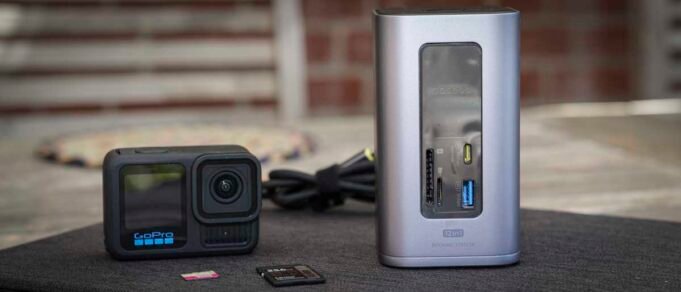Why you can trust TechRadar
We spend hours testing every product or service we review, so you can be sure you’re buying the best. Find out more about how we test.
Baseus Nomos NU1 Air: 30-second review
The Nomos NU1 Air Spacemate is a compact tower-like docking station that enables up to 12 devices and accessories to be plugged into your computer at one time through a single cable. What marks this docking station out against many others is the fact that it’s equally at home in the office as it is out in the field and features two power options.
The first power option is ready to go out of the box and features an integrated USB-C cable that plugs directly into your laptop or computer, enabling you to then use the dock to plug in all of your other accessories. For example, the keyboard, mouse, SSDs, and memory cards will all then appear on your desktop as if you’ve ged them directly into your machine. This option, like many other portable docks, essentially enables you the convenience of a docking station anywhere, which is something that I really like, especially when I’m warming in the field. I often have several different peripherals plugged into my laptop, and it can all get a little bit messy, so a docking station, however small, just helps to keep things neat.
When you’re in the studio or small home office, there’s another power option available to you. Essentially, the NU1 Air Spacemate facilitates a 100W power supply through the PD power USB-C port on the back. Once this is done, that single USB cable from the back of the NU1 Spacemate can then be plugged into your laptop, providing a charge of up to 90W, depending on your system and what other devices are plugged in.
Another feature that really differentiates this small hub from others is the quick power save button on top. As soon as you push it, your machine goes into standby.
In general use, the hub just works; the only thing that I would say is that the transfer rate through that USB cable is limited to just 10Gbps, and likewise, the network cable is only a 1Gbps interface. So, whilst you might have ultra-fast USB 3.2 Gen 2×2 drives attached, you’ll see the slower 10Gbps actually transferring to your machine.
Likewise, if you have multiple devices connected, then that bandwidth needs to be divided between everything. So even if you only have your keyboard, mouse, and monitors plugged in, then start to download from a standard USB 3.2 SSD, again, you will see a drop in the performance of that drive.
The other thing that I’ve seen with docks from other manufacturers is the release of compatible software. This software, such as”Dock Ejector” from OWC, ensures all peripherals are safely ejected before you disconnect, an essential for safeguarding your SSDs.
However, those small points aside, the pure size, convenience, and design of the NU1 Air Spacemate make it one of the best laptop docking stations I’ve used. It’s a simple dock that you can utilise both in the office and out in the field.
Baseus Nomos NU1 Air: Price and availability
- How much does it cost? $99
- When is it out? Now
- Where can you get it? Widely available and direct from the Baseus.com website
The Baseus Nomos NU1 Air Spacemate is available directly through the Baseus UK website for $99 and is also available at most major online retailers for around the same price.
Baseus Nomos NU1 Air: Design
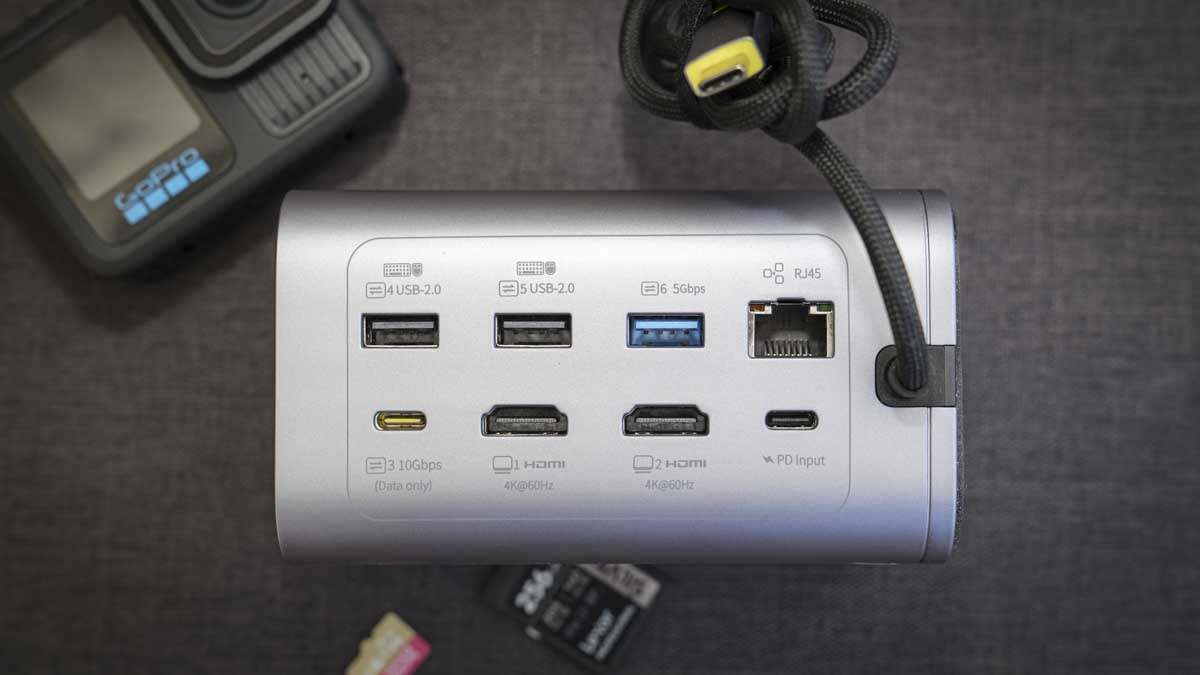
Specifications
Ports: 12
PD Power: 90W (100W input)
Max Transfer rate: 10Gbps
Front ports: USB-C 10Gbps, SD, TF, USB-A 5Gbps
Rear ports: USB-C 10Gbps, 2 x USB-A 480Mbps, 2 x HDMI 4K@60Hz, USB-A 5Gbps, Gigabit Ethernet 1Gbps, USB-C Input power 100W
Ordinarily, when I look at docking stations, they’re long, thin boxes designed to sit underneath your monitor, or alternatively, they’re ultra-light and portable with limited ports. However, the NU1 Spacemate strikes a balance somewhere in between, with a design which is more akin to a portable power bank, with its small tower form providing easy access to ports both front and back.
What I really like about the design is that it has an integrated cable, so there’s no doubt about which port and which cable connects directly to your computer. Once that single cable is plugged in, a light flashes on the top of the tower to say that it’s initiated, and you know then you’re ready to go.
When it comes to size, it is still small and portable, measuring 65 x 65 x 115mm, although the cable sticks a little further out and weighs just 430g. While it does have a bit of weight to it, it’s very portable and will fit in most backpacks and side pockets without too much issue.
Once connected, you can then start to plug in all your peripherals, and if you’re working in a creative setup and use cameras, then the fact that it has an SD and microSD/TF slot on the front just makes things an awful lot easier. The other thing that I really like is that on the front of the box, there is both a USB-C and USB-A port, enabling you to quickly plug in all types of accessories.
As you spin the dock around to the back, all the additional ports are neatly laid out. Again, what I really like here is that each of the ports is properly labelled, so you know exactly what they are and what you’re using when you plug in a device.
Starting from the right-hand side top at the back of the tower, you have two USB 2.0 ports. While these are relatively slow, they’re perfect for your wired keyboard and mouse. Below this is another USB-A port, which is 5Gbps, so USB 3.2, and below this is an RJ45 Gigabit port, so you can plug directly into a wired network; this is a 1Gbps option.
Back to the left-hand side top, you have a USB-C port, which is a 10Gbps option, and below this, you have two HDMI outputs supporting 4K@60Hz. Finally, below this, you have another USB-C port, and this is for PD input if you want to connect a 100W power supply. At the very bottom of the tower is the main USB cable that plugs directly into your computer.
While the hub does support PD input at 100W, it isn’t supplied with a 100W power supply. So, if you want to make the most of utilising it to deliver power to your laptop, for instance, then you will need to purchase one of those separately.
When it comes to design, the style will suit both the studio or office, as well as being used out in the field, with the flexibility to use it either powered from your laptop or from the mains if you have a 100W power supply.
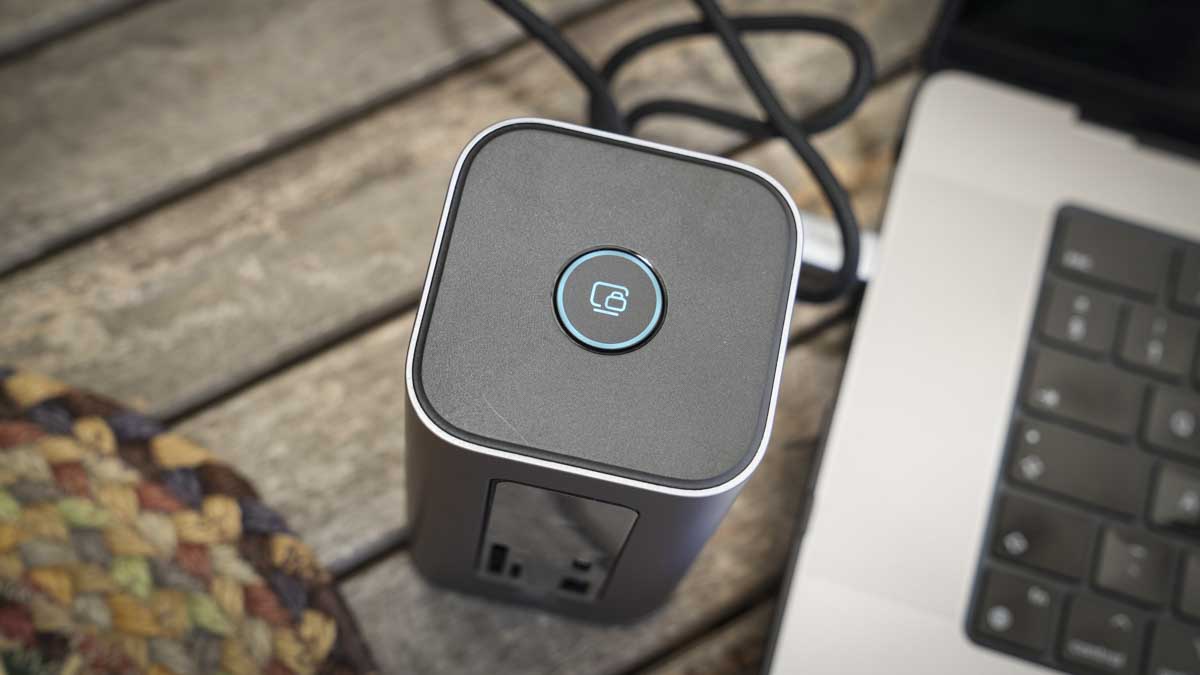
Baseus Nomos NU1 Air: Features
One of the features that I really like about the Nomos NU1 is it strikes a balance between the more sophisticated docking station you use in the office and the smaller, lightweight, portable devices more commonly used in the field.
While the NU1 doesn’t have the ultra-fast transfer speeds, at 10Gbps of those larger stations, what it does offer is still good, and of course, you have the option to plug in up to 12 devices or accessories into the dock and then connect all of them through to your PC or Mac using just a single cable.
So, first and foremost on the feature list, this is a 12-in-1 dock that enables you to plug in various devices through memory card slots, USB, HDMI or networking, giving you a huge array of options to connect to your computer.
When used in the field, it has its obvious advantages. Essentially, if you have a smaller machine with only one or maybe two USB ports, like a MacBook Air, then by having this dock plugged into one of the USB-C ports, you can instantly plug in lots of other devices without having to constantly disconnect and plug in. Everything can essentially plug directly in and then connect to your machine via that one cable.
Then there’s the fact that you can also plug in multiple displays. If you’re a Mac, for instance, you can get a dual display setup. So, if you plug this into your MacBook Pro, then you’ll able to have your MacBook Pro’s screen and a secondary screen plugged in as well. However, you won’t be able to have three monitors all displaying different content, as that’s not supported by Mac systems.
However, if you’re a PC, then yes, you can, and you’ll be able to get up to three displays, all showing different content, all at 4K at 60Hz, which is impressive, as long as your system supports it.
One of the other things that I like is that the feature list marks down AI smart power management, which essentially means that the dock can tell what peripherals are being used and which aren’t, so resources can be directed as needed. It can enable greater bandwidth to, say, a plugged-in SSD compared with another peripheral that might be taking up bandwidth but not being used, and then the AI will switch and push resources to the accessory that is, at that time, in most need.
Finally, one of the features that I also really like is there’s a power-saving option on top of the tower, and this has a dual function: quick press and it will put your computer into sleep mode; hold it down for two seconds, and it will actually just switch off the dock completely. It just makes this really nice, convenient and easy to use.
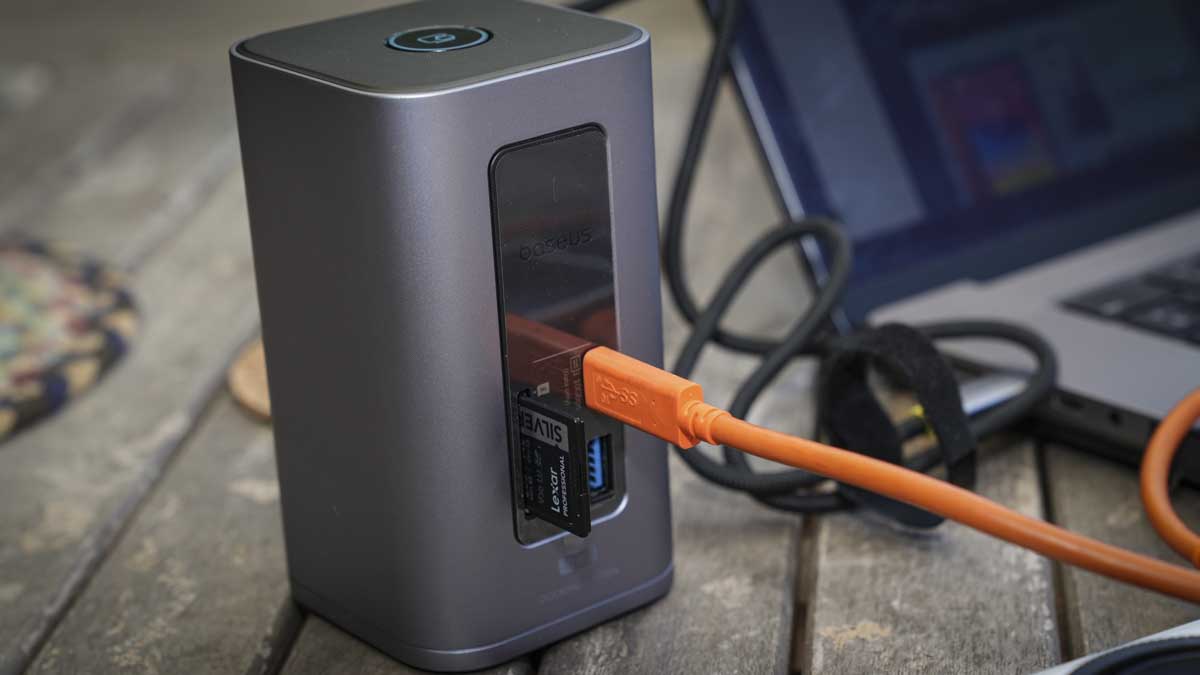
Baseus Nomos NU1 Air: Performance
When it comes to evaluating the Nomos NU1 12-in-1 docking station, you have to look in two different environments, the first being in the field, where it is powered from your laptop, and the second being back in the home studio, where it can be plugged directly into a 100W USB Type-C power supply.
Starting off looking at the NU1 Air Spacemate out in the field and using it on a photo shoot, and I instantly came to appreciate what it was and how well it worked. Firstly, the fact that I could very quickly plug in a keyboard, mouse, and SSD, along with a card reader for CFexpress, and directly plug in microSD and SD cards into the docking station just made things on my small portable desk neat and tidy.
The dock proved to be easy to use, and as I sat going through the images, there was no need to unplug and re-plug different accessories due to a lack of ports around my MacBook Pro.
I also like the fact that I could plug in the secondary display. However, on the MacBook Pro, it’s slightly limiting, as the maximum amount of displays that you can actually utilise is only two, although a third can mirror, so in reality, I could just use the MacBook Pro HDMI port, but again, it’s the neatness of that single cable connection.
When it came to transferring files, I did notice a slight slowdown compared to the usual Thunderbolt 4 transfer rates. But the 10Gbps was still relatively quick. However, the more you put on the hub, the more it has to divide that bandwidth between the microSD, SD, and SSD drives. So, whilst it was relatively quick, I could personally see the slowdown compared to what I’m doing.
Out in the field, however, this performance is on par with most other portable hubs. And what I really like about this particular option, regarding the design, was that it was just nice and solid, really well laid out. I liked the fact that it had the SD card slots on the front; it just made them very accessible. And as I swapped from one card to another, from one camera to another, it was just nice and easy. And there’s enough weight to the hub as well to ensure that it stays nicely put, with a big rubber foot on the base that just helps it grip to the surface.
After using this small docking station out in the field, I’ve been generally impressed with its overall feel and the build quality that has just given me the reassurance that, as a portable hub, it is going to survive for a good few years.
After this shoot, I was back in the studio to download the video files, and here I did find the hub was just a little bit slow as data was copied from a CFexpress card down to an SSD. However, just having the convenience of all of those ports in one place did strike a balance, and the fact that I could use this docking station out in the field as well as back in the studio does add to the overall convenience. That slight slowdown of data transfer also just gives you a little bit more time to go and make coffee and settle in when you get back to the studio.
The file transfer slowdown aside, there’s plenty that I liked about the dock from the outset: the fact that I could plug in a power supply to enable PD power, essentially feeding data and power to my laptop, giving it a full charge while downloading content and all through that single cable. Likewise, my network could be plugged into the back. That was limited to 1Gbps, still faster than my Wi-Fi connection.
My larger monitor could also be connected so that I had my laptop for emails and my larger monitor for actually working on those video files, with keyboard and mouse already neatly plugged in. So if I do have to leave partway through an edit, then I can disconnect the hard drives manually, unplug the single cable, and off I go. There’s no need to unplug HDMI and other accessories; it’s one simple plug to disconnect.
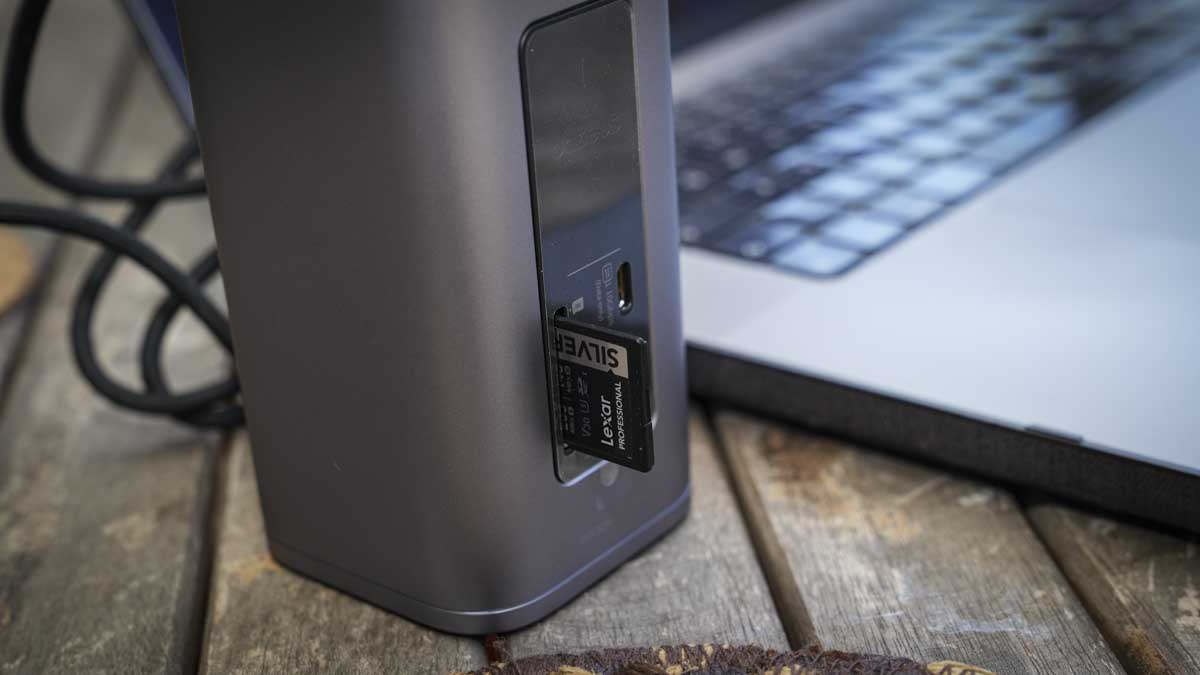
Baseus Nomos NU1 Air: Final verdict
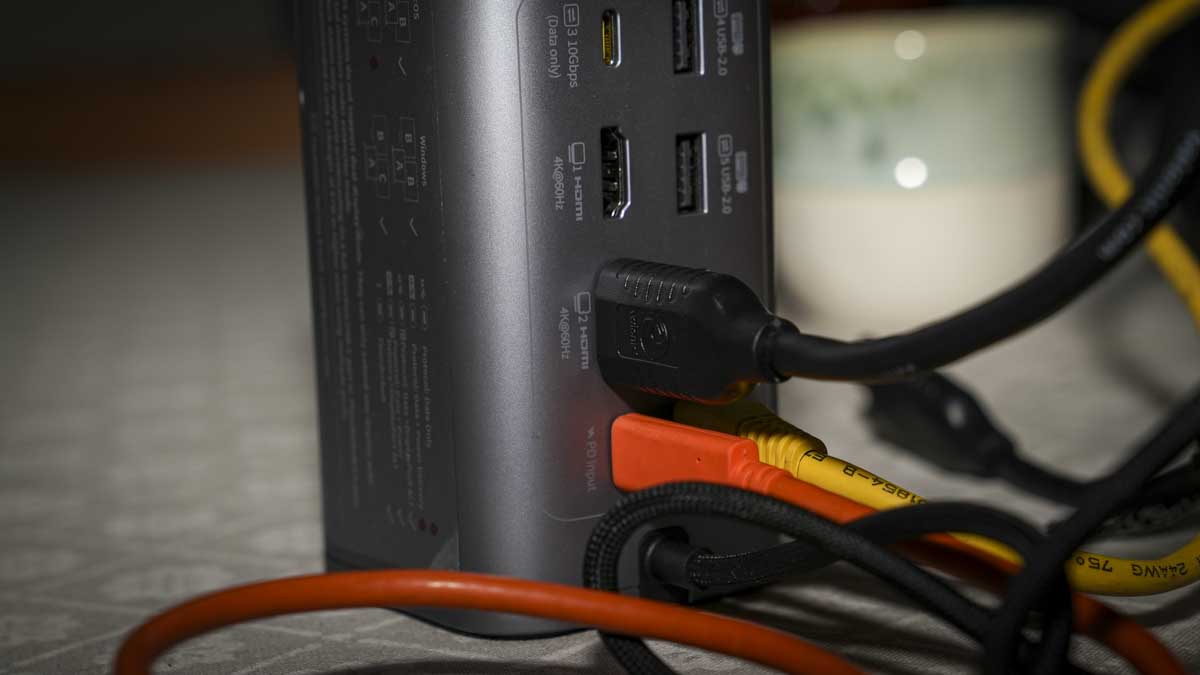
At the end of the test, overall, I was really impressed with the design. It just works really nicely, and the fact that it has a minimal but good selection of ports on the front really does make a difference. I also like the fact that you can use it as a portable hub or, back in the studio/office, you can use it powered so that it can supply your laptop with power at the same time as transferring data.
On the downside, you do have the fact that there is no companion software and data transfer speeds are limited. However, the payoff is pure convenience. And when it comes to portable hubs, while it’s limited to 10Gbps, it just works exceptionally well, even in the studio and for transferring media files.
So, unless you’re loading TBs of data, then for this price, design and the convenience of having a hub that you can take with you or leave in the studio/office, then this is an exceptionally good balance.
Should I buy a Baseus Nomos NU1 Air?
|
Value |
Considering portability and variety of ports, it’s optional value |
4.5 |
|
Design |
The tower design is a little different for docking stations, but it really does work for this particular hub |
5 |
|
Features |
Packed with features when it comes to connectivity, just wish it was a little faster on the transfer rates |
4.5 |
|
Performance |
Decent performance, although limited by that 10Gbps transfer rate |
4 |
|
Overalls |
Overall, a great, well-priced dock with plenty of options that can be used in the office or out in the field |
4 |

